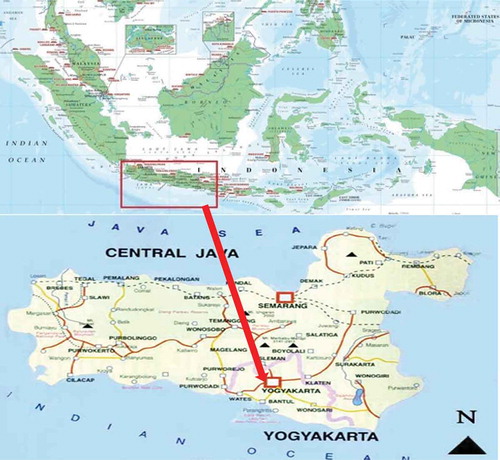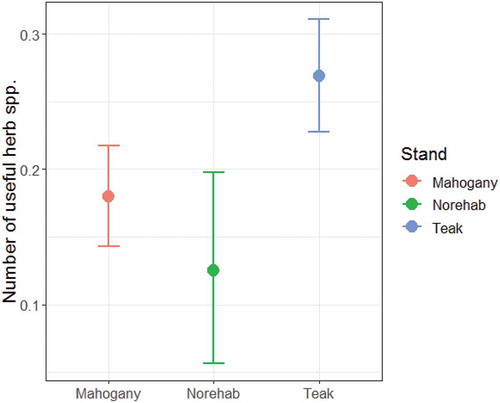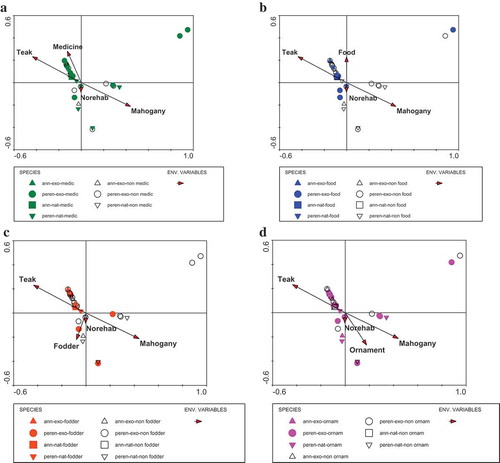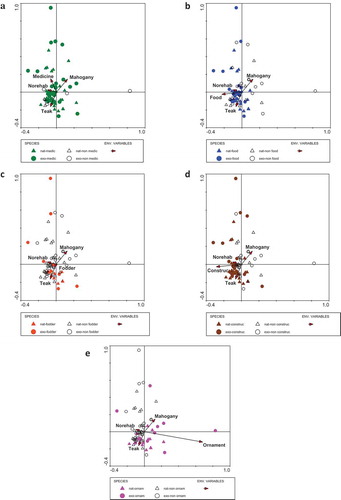ABSTRACT
We investigated herb and woody species at rehabilitated forests planted by mahogany and teak, and original, not rehabilitated forests in Yogyakarta, Indonesia. Plant species were classified into five use categories: medicine, food, fodder, ornament, and construction. We registered 142 species belonging to 54 families known as useful species with at least one, often more, use categories. The number of useful species was highest for medicine use (107 species). There was a dominance of exotic herb species used for food and annual herbs used for fodder. The number of useful herbs and exotic woody species was highest in teak stands. The number of woody species used for medicine, food, and construction was higher than those for ornament and fodder. All herb species decreased with time, except annual native, that increased. Around 50% of the useful species occurred only once in one site, and some species showed a distribution restricted to one type of stands. Overall, our results seem to show that rehabilitated stands are doing well with regard to useful herb and woody species. We suggest strategies for plant and ecosystem conservation, especially for rare native plant species and species with restricted distribution.
Introduction
The reason for people to select certain plants for different uses is a key question in ethnobotany (Alencar, Araújo, Amorim, & Albuquerque, Citation2010; Gaoue et al., Citation2017; Soldati, de Medeiros, Duque-Brasil, Coelho, & Albuquerque, Citation2017). First, the plant species must have the qualities for which it is used. If few species have the quality required, they are worth searching for also in situations that are difficult to reach, collect, or handle. Hence, collection is a trade-off between value and availability. If many species have the quality, species easy to collect will be collected first (Gaoue et al., Citation2017; Soldati et al., Citation2017).
The ongoing global changes in forest use with extensive clear-cuts, often followed by planting of monospecific stands of exotic timber trees (Carnus et al., Citation2006; Lamb, Citation2018; Lamb, Erskine, & Parrotta, Citation2005), have also affected the undergrowth and what plant species that are available (Voeks, Citation1996). Plants with known qualities, for instance for medicinal use, might be confined to the original vegetation in non-cut forests, and be rare or absent in disturbed forests (Voeks, Citation1996). However, also weedy plants found in disturbed areas have been shown to play a major role in traditional plant collection (Stepp & Moerman, Citation2001). For plants with more general uses as food, fodder or construction, people often show flexibility and learn to use new species, or start using species that became common as a result of forestry (Medeiros, Citation2013). These species, often exotic, may therefore be more common in the rehabilitated stands.
Many of the species increasing after cutting the forest are invasive exotic species (Alencar et al., Citation2010; Alencar, Santoro, & Albuquerque, Citation2014; Bennett & Prance, Citation2000; Gama, de Paula, Da Silva, Junior, & de Medeiros, Citation2018), while native species might be rare (Kala, Citation2005). The exotic species are strong competitors with fast growth, and some use allelopathic chemicals to dominate the vegetation and anti-herbivorous substances to avoid herbivory. The fast growth might make plants interesting as food or fodder, and allelopathic and anti-herbivorous chemicals might be interesting for medicine use (Voeks, Citation1996).
South-east Asia has a wide-spread use of wild plants. It is also an area with intense cutting of forests, followed by rehabilitation by single-species plantations (Lamb, Citation2018; Lamb et al., Citation2005). The species composition of herbaceous and spontaneous woody vegetation in these stands is different from that in the rapidly shrinking original forests. Thus, people depending on collecting wild plants might be under pressure.
We studied the sustainability of wild forest species used by people in Java Island, Indonesia, after logging and rehabilitation by planting a single tree species. Plant uses were classified as medicine, food for humans, fodder for livestock, ornament, and construction. We compared uses in plantations of teak, Tectona grandis (L.f.), and of mahogany, Swietenia macrophylla (King), and in fragments of original forest. We hypothesized that: 1) the original forest would have more species used for medicine and more native plant species than the rehabilitated forests, while the rehabilitated forests would have more rare species than the original forest; 2) plants with general uses as food or fodder would include many annual and/or exotic species and mainly be found in the planted stands; 3) the number of useful species would increase with increasing time since rehabilitation; and 4) there would be differences in useful species found in stands with teak and with mahogany. Hypotheses 3 and 4 arise from previous analyses were we show that rehabilitated forests approach the original forests in vegetation quantitative measures, but not in species composition (Udayana, Andreassen, & Skarpe, Citation2019).
Materials and methods
Study area
We worked in the Gunungkidul, Bantul, and Kulonprogo regency (between 110°24‘19‘‘- 110°`28‘53‘‘ E and 7° 15‘ 24‘‘- 7° 49‘ 26‘‘ S) in the province of Yogyakarta, Java Island, Indonesia (). Much of the forest in this area was cut in colonial time or later. After independence in 1945 rehabilitation of the forests increased (Santoso, Citation2012), mainly by planting teak or mahogany (C. Udayana, pers. comm), neither of which is indigenous to Indonesia.
The Yogyakarta Province has a tropical humid climate with average humidity of 84–89% and average temperature of about 26.7°C. The mean monthly minimum and maximum temperatures are 22.6°C and 33.0°C. Annual precipitation is about 3 000 mm. There is a distinct alternation between a rainy season lasting from October to April and a dry season from May to September. Large parts of the area experience water shortage during the dry season. The topography is flat to undulating mainly between 100 and 500 m above sea level (Statistics of Yogyakarta Province, Citation2017).
People live mainly as cultivators with perennial fields. Livestock is largely stall-fed, and fodder is cut for them in the forests.
Field survey
Twenty-seven sites with three sampling plots in each were established for data collection, making a total of 81 sampling plots. Twelve sites had been rehabilitated by planting teak between 1941 and 2003, 12 sites by planting mahogany between 1941 and 1986 and three sites were fragments of original forest never rehabilitated. The low number of original forests sampled was due to the lack of potential sites. The non-rehabilitated forests found and used here were saved for cultural reasons and the trees were protected. The non-rehabilitated forests were small.
At each site, we selected three plots 5 m x 5 m randomly. One plot of 1 m x 1 m was located in the NW corner of each of these 5 m x 5 m plots. We sampled two categories of plant species: (1) herbs including forbs, grasses, and ferns in the 1 m2 plot; (2) woody species encompassing woody vines, shrubs, and trees >50 cm and <2.5 m in height in the 25 m2 plot. Voucher specimens were collected, labeled, and sent to two laboratories, namely the Silviculture laboratory at the Faculty of Forestry, University of Gadjah Mada, Yogyakarta, and Plant conservation service of Purwodadi Botanic Garden, for identification.
Classification of species distribution
We classified the distribution of useful plant species into four categories: (1) widespread species occurring in all stand types (mahogany, non-rehabilitation, teak); (2) intermediate species occurring in two stand types; (3) restricted species occurring at least twice in one stand type; and (4) rare species occurring just once in any of the stand types.
Literature review
We conducted a comprehensive search using databases available through the system of Inland Norway University of Applied Sciences. We used species names to search for used plants, then found information on use, growth habit, status (native, exotic), and life cycle (annual, perennial). The search was compiled from book databases as primary sources (Plant Resources of South-East Asia PROSEA 4 (Mannetje & Jones, Citation1992), PROSEA 5 (Soerianegara & Lemmens, Citation1993), PROSEA 8 (Siemonsma & Piluek, Citation1993), PROSEA 12 (de Padua, Bunyapraphatsara, & Lemmens, Citation1999), and online databases (the agroforestree database, http://www.worldagroforestry.org/output/agroforestree-database), (useful tropical plants database, http://tropical.theferns.info/), (FAO Ecocrop, http://ecocrop.fao.org/), (PROTA4U, http://www.prota4u.info/), the Germplasm Resources Information Network (GRIN, http://www.ars-grin.gov/)).
All the recorded plants were classified according to their use as medicine (e.g. poultice, essential oils, herbal drugs), human food (e.g. fruits, leafy green vegetables, other vegetables, condiments), fodder for livestock and ornament (e.g. pot plants, element of garden, houseplant) (Priyadi et al., Citation2010). For woody species, we also included construction (e.g. house construction, boat building, furniture, interior finish, household implements, music instruments, wood sculptures, and carvings). Use as firewood was not recorded, as all woody species could be used as such (C. Udayana, pers. comm.). Useful plant species have at least one use category, with some having multiple uses. We classified each plant species to the number of uses, 1–4 for herb species and 1–5 for woody species.
Data analyses
For each site, we estimated the mean number of useful plant species per plot and used it as a response in linear models. There was a total of 27 sites in the analyses with all stand types included, and 24 sites in the analyses with rehabilitated forests only (i.e. analysis including time since rehabilitation). For each site, we split the plant species into uses (medicine, food, fodder, ornament, construction [woody species]), plant status (indigenous, exotic) and, for herbs, life cycle (annual, perennial). For herbs, there was a total of 16 potential combinations per site and for woody species 10 (the difference is due to no herbs being used for construction and all woody species being perennials). Total sample size in the linear models was, respectively, 432 and 384 for herbs in models with all stand types and with rehabilitated stands only, and 270 and 240 for woody species in models with all stand types and with rehabilitated stands only.
Due to positive skewness of response variables, we applied a logarithmic transformation, log (Y + 1) to approach the assumptions of homoscedasticity and normal distribution (McDonald, Citation2014). The full model consisted of stand (teak, mahogany, non-rehabilitated), use of plant, life cycle, plant status, and the four-way interaction. For the rehabilitated forests, where we had a time since rehabilitation, we used number of useful species as response in models testing the effect of time since rehabilitation (as a continuous variable), stand (mahogany, teak), use of plant, life cycle of plant, plant status and the five-way interaction between predictor variables. We selected the most parsimonious model by applying a backward selection from the full model until we had only statistically significant (p < .050) components left in the model. All models were carried out using R (version 3.4.2; R Development Core Team, Citation2015).
We made nine ordinations with Correspondence Analysis (CA) of the plant species, i.e. one for each plant use separated for herbaceous and woody plants. In the CA each plant species was classified according to use, life cycle and plant status. In all ordinations, we used the respective use category and stand type as environmental variables and added to the graphs with the best fit. Species with more than one utility were included in more than one ordination. Seven woody species and seven herb species had to be deleted as outliers because they did not fit in the graphs. Forward selection and Monte Carlo simulations (p< .050, 499 iterations; Ter Braak & Šmilauer, Citation1998) in Canonical Correspondence Analyses (CCA) were used to get an idea about the significance of environmental variables. All CA and CCA were performed in the Canoco software (version 4.5 for Windows; Ter Braak & Šmilauer, Citation1998).
Results
Plant species characteristics
Thirty percent of the herbs were annual and the proportion of annual versus perennial herbs did not differ between stand types (χ2 = 0.01, d.f. = 2, p = .993; ). Among herbs there were more exotic useful species (34) than native (21), while it was the opposite in woody species with more native (89) than exotic (54) species (χ2 = 9.31, d.f. = 1, p = .002). All stand types showed the same tendency with a higher proportion of exotic herb and of native woody species.
Table 1. The number of species in the different stands, status (native or exotic) and life cycle (annual and perennial), depending on whether they were defined as rare (occur only once) versus restricted (R – occur in only one stand type), intermediate (I – occur in two stand types) or widespread (W – occur in all three stand types) (R + I + W) in the upper rows of the table, and according to use in the lower rows of the table. Note that some species exist in different stand types and have multiple uses.
Plant species distribution
We recorded a total of 154 plant species encompassing 47 herb species and 107 woody species, where 28 species were identified only to genus level. Out of these, 142 species (45 herbs and 97 woody species) belonging to 54 families are known as useful species. Almost half of the useful species, 49%, was found once in one site and was therefore defined as rare (). There was a tendency for more woody species than herbs to be widespread in all three stand types (; Supplementary Table). There was, however, no significant difference in the distribution frequency between herbs and woody species presented in (χ2 = 4.21, d.f. = 3, p = .230).
Thirty-three percent of the species could be used as medicine irrespective of whether it was a herb or a woody species (). Also, 32% of the herbs could be used as ornaments, while the number of species for other uses was <23%. There was no difference in the frequency of various uses between herbs and woody species presented in (χ2 = 0.97, d.f. = 3, p = .808). There was little difference in the number of used plant species (rare or not) between teak and mahogany stands, both in herbs and woody species. However, non-rehabilitated stands had fewer useful species than the rehabilitated stands ().
Table 2. The number (percentage) of species in different distribution categories.
Table 3. The number (percentage) of species in different use categories, depending on whether they were defined as rare (occur only once) versus restricted (R – occur in only one stand type), intermediate (I – occur in two stand types) or widespread (W – occur in all three stand types) (R + I + W). Note that some species have multiple uses and are therefore counted in several of the use categories.
Number of uses per plant species
The number of uses per plant species ranged from 1 to 3 for herbs, where 41% of the herb species had only one use, 36% had two uses and 23% had three uses (). The number of uses for woody plants ranged from 1 to 5. Most of the woody plants had 2 (35%) or 3 uses (33%), followed by 1 (21%), 4 (6%) or 5 (4%) uses. There were no woody species with five uses, and only two herb species with three uses in non-rehabilitated stands ().
Table 4. The number of useful plant species grouped by the number of potential uses and stand type. Note that the same plants may be present in different stand types.
The herbs with highest number of uses (three different uses) were Bidens pilosa (medicine, fodder, and food),Pteris ensiformis, and Tacca palmata (medicine, ornament and food) in mahogany stands, and Stachytarpheta indica (medicine, ornament, food) and Tridax procumbens (medicine, fodder, food) in teak stands. Synedrella nodiflora (medicine, fodder, food) and Imperata cylindrica (medicine, ornament, fodder) in teak and mahogany stands, and Clitoria ternatea (medicine, ornament, food) in all types of stands (Supplementary Table). The woody species with five uses were Acacia mangium, Albizzia procera, Cassia siamea, and Sterculia foetida in mahogany stands, Gliricidia sepium in teak stands, and Schleichera oleosa in mahogany and teak stands.
Number of useful plant species
There was no interaction effect between stand type and uses on the total number of useful herb species per 1 m2 plot (F6,408 = 1.13, p = .344) or woody plant species per 25 m2 plot (F8,248 = 0.91, p = .512). However, the number of useful herb species per plot was higher in teak than in mahogany and non-rehabilitated stands (F2,418 = 5.04, p < .001; ).
We found an interaction effect between use and plant status (F3,401 = 10.05, p < .001; ) and between use and life cycle (F3,418 = 18.37, p < .001; ), with regard to the number of useful herb species per plot. The number of native herb species used for fodder was higher than that of exotic species, and the number of exotic herb species used for food was higher than that of native species (). The number of annual herb species used as fodder was higher than that of perennial species, and the number of perennial herb species used as ornament was higher than that of annual herb species ().
Figure 3. Interaction effects between (a) plant uses and plant status; and (b) plant uses and plant life cycle, on the number of useful herb species per plot (m2).
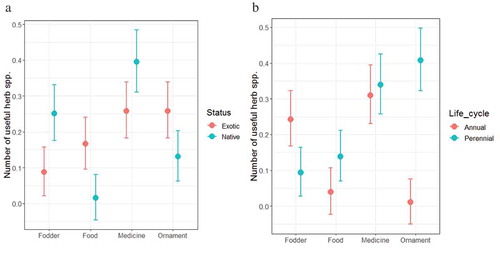
Regarding the number of useful woody species per plot (25m2), there was an interaction effect between stand type and plant status (F2,256 = 4.55, p = .011; ), and between plant use and status (F4,256 = 3.30, p = .01; ). In teak stands the number of useful exotic species was higher than the number of native species (). The number of native and exotic woody species was similar for different uses, except for ornament use, where exotic species were more common than native species ().
Figure 4. Interaction effects between (a) stand type and plant status; and (b) plant uses and plant status, on the number of woody species per 25 m2.
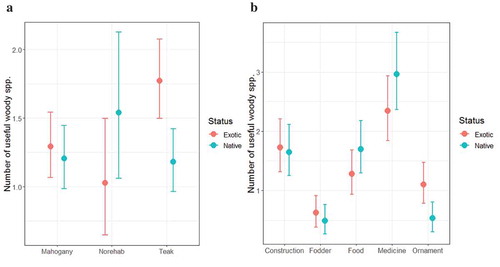
In rehabilitated stands (teak and mahogany), we found a three-way interaction effect in the number of herb species per plot with regard to time since rehabilitation: exotic species and native perennial species decreased, while native annual species increased with time since rehabilitation (F1,350 = 9.16, p = .003; ).
Figure 5. Interaction effects between plant status, plant life cycle and time since rehabilitation (year) on the number of useful herb species per plot (m2).
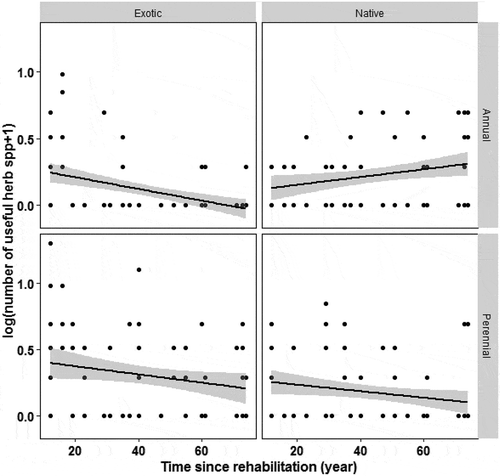
For the number of woody plant species per plot, we found an interaction effect of plant use and time since rehabilitation (F4,223 = 2.85, p = .025). The number of woody species per plot for medicine, construction, and food tended to increase with time since rehabilitation, while the number of species for fodder and ornament did not change with time ().
Ordinations of herb species
CA and forward selection and Monte Carlo simulations in CCA showed influence of stand type on species composition (teak: F = 3.54, p < .002; mahogany: F = 3.48, p < .002; non-rehabilitated: F = 4.20, p < .002; ). Most medicine species showed affinity to teak, while some, mainly perennial-exotic species, were drawn to mahogany and some perennial native species to non-rehabilitated natural forest. Food species were with few exceptions related to teak, and fodder plants to teak, mahogany and non-rehabilitated stands. Of ornament plants, about half showed affinities to teak and the rest to mahogany and non-rehabilitated.
Ordinations of woody species
CA and forward selection in CCA of woody plant species showed an influence of stand types on species distribution (teak: F = 3.51, p < .002; mahogany: F = 3.62, p < .002; non-rehabilitated: F = 5.33, p < .002; ). Woody plant species for fodder did not show a clear affinity, although teak dominated, whereas food species seemed mainly to occur in non-rehabilitated and teak stands. Medicine woody plants also showed an affinity to non-rehabilitated stands. Ornament plants were negatively, and construction plants positively, related to non-rehabilitated stands.
Discussion
Summary of results
We can summarize our results according to our hypothesis as follows:
Hypothesis 1 that the original forest would have more species used for medicine and more native plant species than the rehabilitated forests, while the rehabilitated forests would have more rare species than the original forest, was not confirmed by our results. Actually, single species stands of the exotic trees, teak, and mahogany, had a relatively large number of useful herbs and woody species compared to the few stands of non-rehabilitated natural forests.
Hypothesis 2 that many plants used as food or forage would be annual and/or exotic and be found in the rehabilitated stands was partly confirmed. Food plants were mainly exotic, and plants used as fodder were annual and exotic, and were mainly found in the rehabilitated stands.
Hypothesis 3 that the number of useful plant species would increase with time since rehabilitation was also confirmed for woody species that could be used for medicine, construction, and food, whereas ornament and fodder species did not change. For herbaceous species, there was a decrease in number of useful species except for native annual plants that increased.
Hypothesis 4 that there would be differences in plant occurrences between the stand types was partly confirmed by the ordinations, as for instance teak stands had more useful species than the other stand types.
Plant species distribution
About half of the plant species registered were classified as rare as they occurred only once in one site. There were many more widespread species in woody plants than in herbaceous species, which might reflect the more stable nature of woody plants, establishing and growing with the stand, competing for light and other resources. Species with restricted distribution were more common among herbaceous than woody plants, possibly as many herbaceous pioneer species establish and stay for one or a few years before being outcompeted by other herbs or by the growing tree stand.
Species distribution depends on the availability of suitable habitat, the capacity to disperse to these habitats, and the capacity of populations to persist after establishment (Ehrlén & Eriksson, Citation2000). Long distance seed dispersal can be critical (Cain, Milligan, & Strand, Citation2000), and more so the more the forest is fragmented. Long distance dispersal often needs the assistance of insects, birds or mammals, who’s occurrence in turn can depend on vegetation composition and structure (Carnus et al., Citation2006).
Plant species that had an intermediate or widespread distribution usually had few occurrences in non-rehabilitated stands (). It should be remembered that there were 12 stands each of teak and mahogany, but only 3 stands of non-rehabilitated natural forest. This may have been too few to show a representative species distribution. This might explain why there is only one useful woody species with restricted distribution in the non-rehabilitated forest, Macaranga tanarius.
Number of uses per useful species
Multiple use of plants is quite common. More than 50 000 plant species have been used as medicine in many countries around the world (Schippmann, Leaman, & Cunningham, Citation2002). Out of these, about 1 000 species can be found in Indonesia (Schippmann et al., Citation2002). However, many of the same species can also contribute as food species, often collected to provide side dishes and diversity and serving as a source of vitamins and minerals (Pardo-De-Santayana, Tardío, & Morales, Citation2005). Furthermore, legumes are commonly used as fodder for ruminants in much of the dry tropics, probably due to their high nitrogen content as they are nitrogen fixing (Simbaya, Citation2002; Topps, Citation2009), and some of these species do also serve as human food, e.g. Leucaena leucocephala (Garcia, Ferguson, Neckles, & Archibald, Citation1996).
More complex plants, such as trees and shrubs, are more likely to be useful plants (with potential uses from bark and wood) than herb species (Tardío & Pardo-de-Santayana, Citation2008). We found similar results as 41% of the herbs had only one use, while 33% of the woody plants had three uses. As medicine use is the most common, most combinations contain medicine, often together with food (57 cases) or fodder (21 cases).
Multiple use was most common in the rehabilitated stands. There were no woody species with five uses, and only two herb species with three uses in the non-rehabilitated stands. Similar results were mentioned by Lykke, Kristensen, and Ganaba (Citation2004) and Ayantunde, Hiernaux, Briejer, Udo, and Tabo (Citation2009), who recorded multipurpose uses of woody plants. We do not know the reasons for this pattern, but useful and sought for plants in the non-rehabilitated forests might have been collected to rareness or extinction (Kala, Citation2005).
Number of useful plant species
We found a higher number of useful herb species per plot in teak than in mahogany or non-rehabilitated stands. For woody species, there was no difference between stands, but exotic species dominated in teak, suggesting a more disturbed environment in teak plantations than in mahogany (Biswas & Das, Citation2016; Bruijnzeel, Bonell, Gilmour, & Lamb, Citation2005; Manimegalai, Citation2012). Hence, the higher number of useful herb species in teak plantations than in non-rehabilitated stands might partly be explained by the few stands of original forest sampled, but could also depend on collectors’ preference for weedy species on disturbed land (Stepp, Citation2004).
The number of useful native woody plants did not differ between stand types, but the number of exotic species was highest in teak stands. Also, the number of useful herbaceous species was higher in teak than in mahogany and non-rehabilitated stands. Tropical primary forest is usually considered most important for traditional plant collectors, but as pointed out by Stepp and Moerman (Citation2001), the use of plants growing in disturbed sites have often been overlooked as well as the use of new exotic plants (Medeiros, Citation2013). We found that exotic species was mainly used for food and annual species for fodder. This might indicate the use of short-lived species exploring disturbed sites, such as some weedy species.
Annual and perennial, native and exotic, herbs and woody species were all used for medicine. This multiple source of medicine plants might be the reason that they were frequently used also as food and fodder. The more specific medicine plants may contain poisonous substances and might be found in the natural forests (de Padua et al., Citation1999).
Ordination of herb species
We used CA to identify species patterns and the environmental influence on useful plant species. Environmental variables (stand type and use) influenced the position of many of the useful species in the ordinations. Seven herb species did not fit in the graphs and were excluded. These were mainly rare and native species, although not many occurred in the non-rehabilitated stands.
There was a general aggregation of useful herbs towards teak stands, supporting Stepp (Citation2004) on the great importance of weedy species in plant collection. In addition, for medicinal plants, some native perennial species had affinity to non-rehabilitated stands and to mahogany. That suggests the dual distribution of many species in disturbed sites and a few specific ones in non-rehabilitated stands. As expected, food and fodder species were mainly fast-growing exotic species mainly in the teak stands, but also a few in non-rehabilitated and mahogany stands. Ornament plants showed the largest spread around the non-rehabilitated and mahogany stands.
Ordination of woody species
CA of woody species showed a variation in useful plant species composition with stand type. Seven species did not fit in the graph and were excluded. These were mainly ordinary species with uncommon allocation in the ordination graphs. There were more woody species than herbaceous, and the spread of species was greater. All use categories showed more or less concentration around teak stands, strongest for food and fodder species. Medicine had a spread of species with affinity to mahogany along axis 2, but not specifically native or exotic species. Ornament woody species, showed a strong negative relationship to non-rehabilitated stands, illustrating the group’s exotic character. Woody species for construction, on the other hand, had many species occurring in teak stands and many in non-rehabilitated stands, with a widespread of species along axis 2 and mahogany.
Conclusion
This study is unique as we have used a large data sample at the plant species level to analyze how plant uses correlate with forest rehabilitation. Generally, our results are quite positive for the sustainability of rehabilitated stands showing that they are doing well with regard to the number of useful species. Still, we know what species are collected today, but not what was collected from natural forests before forest clearance and rehabilitation. In addition, rehabilitated forests have a different species composition compared to non-rehabilitated forests with unknown long-term consequences for sustainability. Forest plantations are relatively young anthropogenic ecosystems compared to natural forests, and with just one tree species they offer fewer habitats than a natural forest with a mixture of species, life forms, ages of trees and of dead wood. Plantations of exotic trees are known to suppress native vegetation (Braun & Vogt, Citation2014; Tulod, Casas, Marin, & Ejoc, Citation2017; Wijesinghe & de Silva, Citation2012).
Our results are of course affected by the number and location of the non-rehabilitated forests. The small fragments of natural forest are difficult to find. They are still the least disturbed stands we observed and have served as a reference for an original natural forest. While teak stands have the highest number of useful herb species, they are the most disturbed stands (Biswas & Das, Citation2016; Bruijnzeel et al., Citation2005; Manimegalai, Citation2012). We do not know whether the limited occurrence of rare species and species with restricted distribution is natural or caused by deforestation and rehabilitation. It shows, however, the need for protection of species and ecosystems for plant collectors and to promote the functioning of ecosystems and general ecosystem services. This requires a forestry with planting of stands with more species and more indigenous species (Carnus et al., Citation2006; Lamb, Citation2018; Lamb et al., Citation2005). By mixing stands with different species compositions and ages, intermingled with what remains of natural forest stands and stands with rehabilitation of the original tree species composition, landscape biodiversity is promoted (Carnus et al., Citation2006). Connectivity between stands facilitates the distribution of animals, that help with pollination and long-distance seed dispersal.
Supplemental Material
Download PDF (888 KB)Acknowledgments
The authors acknowledge the financial support for the fieldwork, granted by Inland Norway University of Applied Sciences (INN). We thank the following institutions for permitting us access to the forests: Wanagama management, Faculty of Forestry, University of Gadjah Mada; Forestry Service; and Natural Resources Conservation Center in Yogyakarta. We especially thank Sukirno D. P. and Sakiran guided survey. Wanagama personnel helped for data collection. We acknowledge the help of Wiyono, Faculty of Forestry, University of Gadjah Mada, and Edi Suroto, Purwodadi Botanic Garden with plant identification. We would also like to thank two anonymous reviewers for helpful comments on this manuscript.
Supplementary material
Supplemental data for this article can be accessed here.
References
- Alencar, N. L., Araújo, T. A. S., Amorim, E. L. C., & Albuquerque, U. P. (2010). The inclusion and selection of medicinal plants in traditional pharmacopoeias – Evidence in support of the diversification hypothesis. Economic Botany, 64(1), 68–79. doi:10.1007/s12231-009-9104-5
- Alencar, N. L., Santoro, F. R., & Albuquerque, U. P. (2014). What is the role of exotic medicinal plants in local medical systems? A study from the perspective of utilitarian redundancy. Brazilian Journal of Pharmacognosy, 24(5), 506–515. doi:10.1016/j.bjp.2014.09.003
- Ayantunde, A. A., Hiernaux, P., Briejer, M., Udo, H., & Tabo, R. (2009). Uses of local plant species by agropastoralists in south-western Niger. Ethnobotany Research & Applications, 7, 53–66. Retrieved from http://ethnobotanyjournal.org/vol7/i1547-3465-07-053.pdf
- Bennett, B. C., & Prance, G. T. (2000). Introduced plants in the indigenous pharmacopeia of Northern South America. Economic Botany, 54(1), 90–102. doi:10.1007/BF02866603
- Biswas, K., & Das, A. P. (2016). Allelopathic effects of teak Tectona grandis L.f. on germination and seedling growth of Plumbago zeylanica L. Pleione, 10(2), 262–268.
- Braun, A. C., & Vogt, J. (2014). A multiscale assessment of the risks imposed by plantation forestry on plant biodiversity in the hotspot central Chile. Open Journal of Ecology, 4(16), 1025–1044. doi:10.4236/oje.2014.416085
- Bruijnzeel, L. A., Bonell, M., Gilmour, D. A., & Lamb, D. (2005). Forests, water, and people in the humid tropics: An emerging view. In M. Bonell & L. A. Bruijnzeel (Eds.), Forests, water, and people in the humid tropics (pp. 906–925). Cambridge: Cambridge University Press.
- Cain, M. L., Milligan, B. G., & Strand, A. E. (2000). Long‐distance seed dispersal in plant populations. American Journal of Botany, 87(9), 1217–1227. doi:10.2307/2656714
- Carnus, J. M., Parrotta, J., Brockerhoff, E., Arbez, M., Jactel, H., Kremer, A., … Walters, B. (2006). Planted forests and biodiversity. Journal of Forestry, 104(2), 65–77. doi:10.1093/jof/104.2.65
- de Padua, L. S., Bunyapraphatsara, N., & Lemmens, R. H. M. J. (editors). (1999). Plant resources of South-East Asia No 12 (1). Medicinal and poisonous plants 1. Leiden, the Netherlands: Backhuys Publishers.
- Ehrlén, J., & Eriksson, O. (2000). Dispersal limitation and patch occupancy in forest herbs. Ecology, 81(6), 1667–1674. doi:10.1890/0012-9658
- Gama, A. D. S., de Paula, M., Da Silva, R. R. V., Junior, W. S. F., & de Medeiros, P. M. (2018). Exotic species as models to understand biocultural adaptation: Challenges to mainstream views of human-nature relations. PlosOne, 13(4), 1–18. doi:10.1371/journal.pone.0196091
- Gaoue, O. G., Coe, M. A., Bond, M., Hart, G., Seyler, B. C., & McMillen, H. (2017). Theories and major hypotheses in ethnobotany. Economic Botany, 71(3), 269–287. doi:10.1007/s12231-017-9389-8
- Garcia, G. W., Ferguson, T. U., Neckles, F. A., & Archibald, K. A. E. (1996). The nutritive value and forage productivity of Leucaena leucocephala. Animal Feed Science and Technology, 60(1–2), 29–41. doi:10.1016/0377-8401(95)00922-1
- Kala, C. P. (2005). Indigenous uses, population density and conservation of threatened medicinal plants in protected areas of the Indian Himalayas. Conservation Biology, 19(2), 368–378. doi:10.1111/j.1523-1739.2005.00602.x
- Lamb, D. (2018). Undertaking large-scale forest restoration to generate ecosystem services. Restoration Ecology, 26(4), 657–666. doi:10.1111/rec.12706
- Lamb, D., Erskine, P. D., & Parrotta, J. A. (2005). Restoration of degraded tropical forest landscapes. Science, 310(5754), 1628–1632. doi:10.1126/science.1111773
- Lykke, A. M., Kristensen, M. K., & Ganaba, S. (2004). Valuation of local use and dynamics of 56 woody species in the Sahel. Biodiversity and Conservation, 13(10), 1961–1990. doi:10.1023/B:BIOC.0000035876.39587.1a
- Manimegalai, A. (2012). Allelopathic effect of Tectona grandis leaves on protein content changes of black gram anf green gram. International Journal of Current Science, 4, 30–34.
- Mannetje, L., & Jones, R. M. (editors). (1992). Plant resources of South-East Asia. No. 4: Forages. Wageningen, Netherlands: Pudoc Scientific Publishers.
- McDonald, J. H. (2014). Handbook of biological statistics, 3rd ed. Baltimore, Maryland, U.S: Sparky House Publishing. Retrieved from http://www.biostathandbook.com/HandbookBioStatThird.pdf
- Medeiros, P. M. (2013). Why is change feared? Exotic species in traditional pharmacopoeias. Ethnobiology and Conservation, 2(3), 1–5. doi:10.15451/ec2013-8-2.3-1-05
- Pardo-De-Santayana, M., Tardío, J., & Morales, R. (2005). The gathering and consumption of wild edible plants in the Campoo Cantabria, Spain. International Journal of Food Sciences and Nutrition, 56(7), 529–542. doi:10.1080/09637480500490731
- Priyadi, H., Takao, G., Rahmawati, I., Supriyanto, B., Nursal, W. I., & Rahman, I. (2010). Five hundred plant species in Gunung Halimun Salak National Park, west Java. A checklist including Sundanese names, distribution and use. Bogor, Indonesia: Center for International Forestry Research (CIFOR). doi:10.17528/cifor/003235
- R Development Core Team (2015). Retrieved from https://www.r-project.org/
- Santoso, H. (2012). Pengelolaan Sumber Daya Hutan, Tanah dan Air Berbasis Daerah Aliran Sungai [Management of forest, land, and water resources based on watershed]: Bunga Rampai Pemikiran Mendukung Pembangunan Hutan Berkelanjutan. Banten, Indonesia: Wana Aksara.
- Schippmann, U., Leaman, D. J., & Cunningham, A. (2002). Impact of cultivation and gathering of medicinal plants on biodiversity: Global trends and issues. FAO. 2002. Biodiversity and the ecosystem approach in agriculture, forestry and fisheries. Satellite event on the occasion of the ninth regular session of the commission on genetic resources for food and agriculture. 12–13 October 2002. Rome: Inter-Departmental Working Group on Biological Diversity for Food and Agriculture. Retrieved from http://www.fao.org/3/AA010E/AA010e00.htm
- Siemonsma, J. S., & Piluek, K. (1993). Plant resources of South-East Asia. No. 8. Vegetables. Wageningen, the Netherlands: Pudoc Scientific Publishers.
- Simbaya, J. (2002). Potential of fodder tree/shrub legumes as a feed resource for dry season supplementation of smallholder ruminant animals. Chilanga, Zambia. Retrieved from https://inis.iaea.org/collection/NCLCollectionStore/_Public/33/032/33032973.pdf
- Soerianegara, I., & Lemmens, R. (1993). Plant resources of southeast Asia. Wageningen, the Netherlands: Pudoc Scientific Publishers.
- Soldati, G. T., de Medeiros, P. M., Duque-Brasil, R., Coelho, F. M. G., & Albuquerque, U. P. (2017). How do people select plants for use? Matching the ecological apparency hypothesis with optimal foraging theory. Environment, Development and Sustainability, 19(6), 2143–2161. doi:10.1007/s10668-016-9844-1
- Statistics of Yogyakarta Province. (2017). Provinsi daerah istimewa Yogyakarta dalam angka [Daerah istimewa Yogyakarta province in figures]. Yogyakarta Province, Indonesia: BPS-Statistics of D.I. Retrieved from https://yogyakarta.bps.go.id/
- Stepp, J. R. (2004). The role of weeds as sources of pharmaceuticals. Journal of Ethnopharmacology, 92(2–3), 163–166. doi:10.1016/j.jep.2004.03.002
- Stepp, J. R., & Moerman, D. E. (2001). The importance of weeds in ethnopharmacology. Journal of Ethnopharmacology, 75(1), 19–23. doi:10.1016/S0378-8741(00)00385-8
- Tardio, J., & Pardo-de-Santayana, M. (2008). Cultural importance indices: A comparative analysis based on the useful wild plants of Southern Cantabria (Northern Spain). Economic Botany, 62(1), 24–39. doi:10.1007/s12231-007-9004-5
- Ter Braak, C. J. F., & Šmilauer, P. (1998). Canoco reference manual and user’s guide to Canoco for Windows software for canonical community ordination (version 4.5). Retrieved from http://library.wur.nl/WebQuery/wurpubs/341885
- Topps, J. H. (2009). Potential, composition and use of legume shrubs and trees as fodders for livestock in the tropics. Journal of Agricultural Science, 118(1), 1–8. doi:10.1017/S0021859600067940
- Tulod, A. M., Casas, J. V., Marin, R. A., & Ejoc, J. A. B. (2017). Diversity of native woody regeneration in exotic tree plantations and natural forest in Southern Philippines. Forest Science and Technology, 13(1), 31–40. doi:10.1080/21580103.2017.1292958
- Udayana, C., Andreassen, H. P., & Skarpe, C. (2019). Understory diversity and composition after forest rehabilitation, Yogyakarta, Indonesia (Unpublished).
- Voeks, R. A. (1996). Tropical forest healers and habitat preferences. Economic Botany, 50(4), 381–400. doi:10.1007/BF02866520
- Wijesinghe, M. R., & de Silva, V. R. (2012). Conservation value of forest plantations: A study of four timber species in Sri Lanka. Journal of Tropical Forestry and Environment, 2(1), 36–47. doi:10.31357/jtfe.v2i1.566

